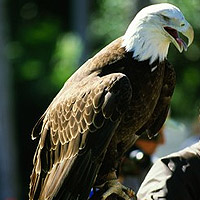Birds - Northern Bald Eagle
 Region:
North America Region:
North America
Class: Aves
Order: Falconiformes
Family: Buteoninae
Genus: Haliaetus
Scientific Name: Haliaeetus leucocephalus
Description: The beak, cere and feet of the adults are
yellow. Size: 60 to 70 cm Wingspan: 2.2 m
Distribution: Once common throughout North America. The
last stronghold is the northwestern British Columbia/Alaska
coastal areas. They also occur in the rest of the USA
and Canada, but in greatly reduced numbers.
Habitat: Usually the vicinity of water; larger rivers,
lakes, sea coasts and the adjacent countryside.
Food: About 60% of the diet is made up of fish. They feast
on the salmon "die-off" following the annual
spawning on the west coast. Will also take rodents and
smaller mammals. In Canada, it is more of a scavenger.
Skin/Color/Coat: Head, neck and tail are white, rest of
plumage, dark brown. The white of the adult plumage takes
4 to 6 years to appear and the "immature" birds
are black in colour.
Vocalization: Eagles make a wide variety of high pitched
squawks.
Reproduction and Development: It is believed that these
birds "mate for life" and it is known that they
return each year to the same nest site. Every year more
building material is added to refurbish the nest and after
several years, it may weigh hundreds of pounds. Almost
invariably two white eggs are laid. The breeding season
is spring and early summer in the northern subspecies
and around October in the southern subspecies. Fledglings
leave the nest at 10-13 weeks of age but remain near the
nest to be cared for by the parents for the remainder
of the summer. The eggs hatch within a few days of one
another and the older nestling may feed at the expense
of his younger sibling causing a relatively high mortality
in young. Breeding occurs after maturity at 4-6 years.
Adaptations: An adept fisherman. Bald eagles may sit for
hours on some dead bough or other vantage point over shallow
water, waiting for fish to rise, then swoop to capture
one from the surface, barely getting their feet wet. It
frequently swoops into or at right angles to the sun in
order that its shadow not frighten the fish and cause
them to dive out of reach. The bald eagle will also attack
diving birds and swoops at them until they are exhausted
from diving which makes them easy prey. Fish or birds
that are too heavy to lift are towed to shore over the
water's surface. This bird has made the visual adaptation
necessary to enable it to strike fish where they are rather
than where they appear to be due to refraction created
by water.
Threats: Vulnerable to pesticides in the environment that
bioaccumulate in higher levels of the food chain.
Status: Common in its northwestern range. Recent studies
indicate it has made a significant recovery in other parts
of North America. It is a protected species and possession
of a single feather by an American citizen is a criminal
offence.
References: Godfrey, W. E. ,The Birds of Canada, The Queen’s
Printer, Ottawa, 1966, Pp. 428. Grossman-Hamlett, Birds
of Prey of the World 1964 USA |
|
|
